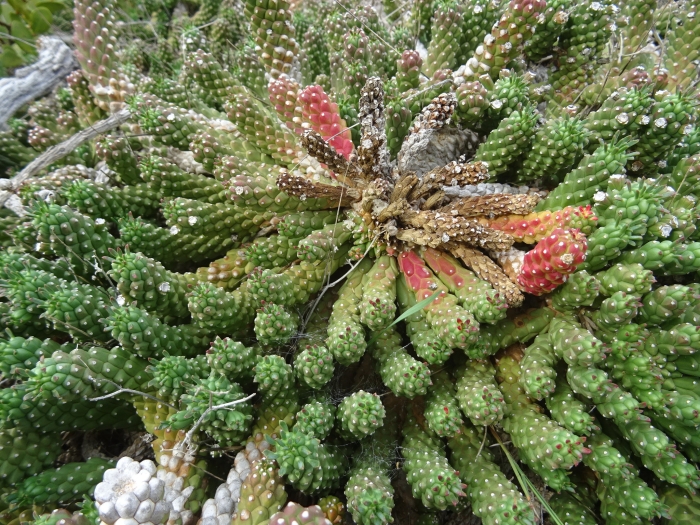Medusa’s Head
(Euphorbia caput-medusae)
Medusa’s Head (Euphorbia caput-medusae)
/
/

Paul Hoekman
Public Domain
Image By:
Paul Hoekman
Recorded By:
Copyright:
Public Domain
Copyright Notice:
Photo by: Paul Hoekman | License Type: Public Domain | License URL: http://creativecommons.org/publicdomain/zero/1.0/ | Rights Holder: Paul Hoekman | Publisher: iNaturalist | Date Created: 2019-05-14T11:47:40-07:00 |



















































Estimated Native Range
Summary
Euphorbia caput-medusae, commonly known as Medusa’s Head, is a perennial succulent native to the dry, rocky slopes and coastal plains of the Western Cape and Northern Cape provinces of South Africa. This distinctive plant is characterized by its numerous serpent-like stems, which emerge from a short, central caudex that can sometimes exceed 1 meter in diameter and is often partly buried in the ground. The branches are crowded and can give the plant an overall diameter of up to 2 meters. Medusa’s Head blooms in the spring, producing small, inconspicuous yellow flowers that are not particularly showy but are interesting upon close inspection.
In cultivation, Medusa’s Head is valued for its unique, sculptural form that adds an exotic touch to rock gardens, succulent collections, and xeriscapes. It is drought-tolerant and requires minimal maintenance, making it suitable for gardeners seeking low-water-use plants. It thrives in full sun and well-draining soils, and it is best to water sparingly to mimic its natural arid conditions. While it is generally pest-free, it can be susceptible to root rot if overwatered. Due to its potential to cause skin irritation or an allergic reaction, it should be handled with care, and it is recommended to wear gloves when working with this plant.CC BY-SA 4.0
In cultivation, Medusa’s Head is valued for its unique, sculptural form that adds an exotic touch to rock gardens, succulent collections, and xeriscapes. It is drought-tolerant and requires minimal maintenance, making it suitable for gardeners seeking low-water-use plants. It thrives in full sun and well-draining soils, and it is best to water sparingly to mimic its natural arid conditions. While it is generally pest-free, it can be susceptible to root rot if overwatered. Due to its potential to cause skin irritation or an allergic reaction, it should be handled with care, and it is recommended to wear gloves when working with this plant.CC BY-SA 4.0
Plant Description
- Plant Type: Succulent
- Height: 2-3 feet
- Width: 2-3 feet
- Growth Rate: Slow
- Flower Color: Yellow
- Flowering Season: Spring
- Leaf Retention: Deciduous
Growth Requirements
- Sun: Full Sun
- Water: Very Low, Low
- Drainage: Medium, Fast
Common Uses
Bee Garden, Bird Garden, Butterfly Garden, Deer Resistant, Drought Tolerant, Fragrant, Low Maintenance, Rabbit Resistant
Natural Habitat
Dry, rocky slopes and coastal plains of the Western Cape and Northern Cape provinces of South Africa
Other Names
Common Names: Medusenhaupt-Wolfsmilch, Medusahuvud
Scientific Names: , Euphorbia caput-medusae, Euphorbia ramiglans, Euphorbia muirii, Euphorbia tuberculata, Euphorbia marlothiana, Euphorbia macowanii, Euphorbia tuberculata var. macowanii, Euphorbia tuberculatoides, Euphorbia commelini
GBIF Accepted Name: Euphorbia caput-medusae L.